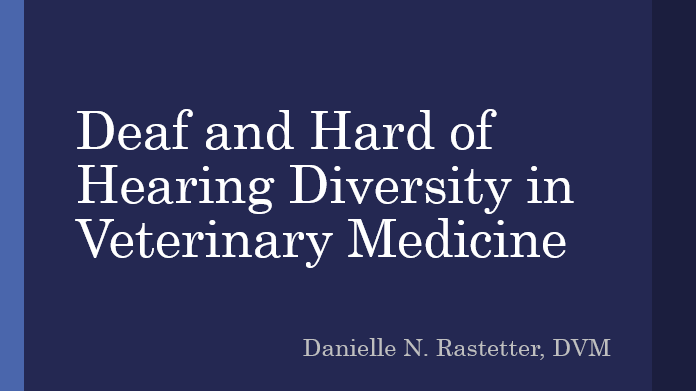

Last week was an eventful one for our team! Along with incoming first year veterinary student Christina Whetsel, I recently led the Student American Veterinary Medical Association’s 2020 Diversity and Inclusion Webinar Series focused on Deaf and Hard of Hearing (DHH). The webinar was hosted with the support of Hill’s Pet Nutrition.
Veterinarians and their staff will most likely interact with the DHH as pet parents. Appropriate communication and understanding of a pet’s needs is paramount to all pet parents and incumbent on the veterinary staff to ensure. Thus, communication strategies were reviewed during the webinar. Many hearing individuals believe excellent speech reading is a shared DHH skill, which is not true. Thus, strategies such as reducing environmental noise, assistive hearing technology, non-verbal forms of communication, interpreters, and speech to text modalities were introduced.
DHH individuals need support to ensure they understand. Embarrassment and fatigue can cause a DHH individual to imply they understand when they do not and often will be signaled in other ways. On the veterinary staff’s side, time, effort, and sometimes finances are required to ensure communication occurs. The desire to ensure complete communication occurs must be fueled by empathy and understanding for the DHH individual and a desire to provide veterinary care not limited by lack of communication.
Christina and I described experiences as DHH individuals in the veterinary education system and profession. Discrimination has been encountered ranging from lack of accommodations impacting education and employment along with the negative attitudes of others. Those experiences lead to depression and feelings of isolation. The individuals that provided support helped to counteract that whether they be family, friends, fellow students, coworkers, educators, employers, or fellow DHH medical professionals/students.
My experiences in veterinary school led to co-founding a non-profit, the Association of Medical Professionals with Hearing Losses (www.amphl.org). This organization focuses on advocacy, networking, technology development (such as specialized auscultation tools and clear surgical masks), and mentoring to assist DHH individuals that are interested in or already within various medical fields. AMPHL has been involved in legal cases that have opened doors and set precedents for the DHH within medicine. Educators, disability offices, employers, government programs, and training programs often reach out to AMPHL for information.
Our last topic related to discriminatory technical standards and job descriptions. Technical standards are outlines of skill expectations for students. Both often focus on organic methods. For example, The Ohio State University College of Veterinary Medicine states, “The student must be able to communicate efficiently and effectively in both oral and written forms using English.” Instead, an inclusive technical standards example would be, “The student must be able to communicate effectively with patients and family, and other members of the healthcare team. The communication skills require the ability to assess all the information including the recognition of the significance of nonverbal responses and immediate assessment of information provided to allow for appropriate, well-focused follow-up inquiry. The student must be capable of responsive, empathetic listening to establish rapport in a way that promotes openness on issues of concern and sensitivity to potential cultural differences.” Job descriptions often are written similar to technical standards.
Diversity within veterinary medicine brings a wealth of benefits. Those that rely or supplement their understanding with non-verbal communication are often highly attuned to non-verbal communication in others. Picking up on hints that something has been left unspoken helps provide better care to both pets and clients. Those that advocated for their own communication needs are often sensitive regarding communication skills helpful to staff and clients. I have been able to utilize my amplified stethoscope in such a way as to out-perform hearing peers. Experiencing discrimination often leads to greater awareness of bias against and supporting advocacy for other underrepresented groups. Christina and I are examples that being DHH can lead to confidence, resiliency, assertiveness, empathy, creativity…great traits to have in the workforce.
Unfortunately, diversity efforts in veterinary medicine are often focused on gender, race, and ethnicity – not different abilities. Hearing loss is a silent disability present in many individuals and increases with age. The DHH can be found as pet parent, coworker, student, and even oneself. Support and the desire for communication can build relationships and improve the lives of both people and animals.
